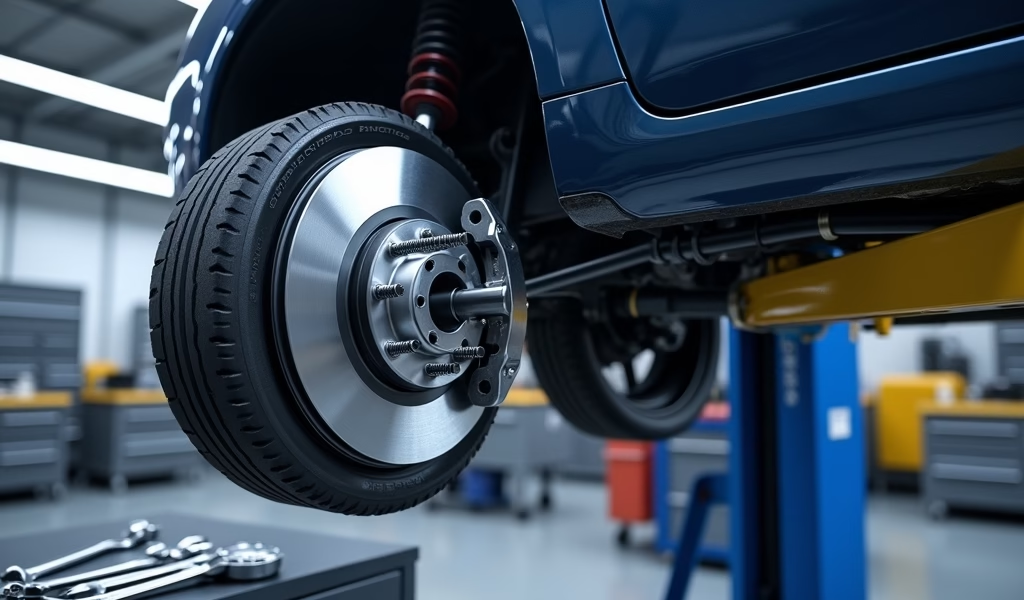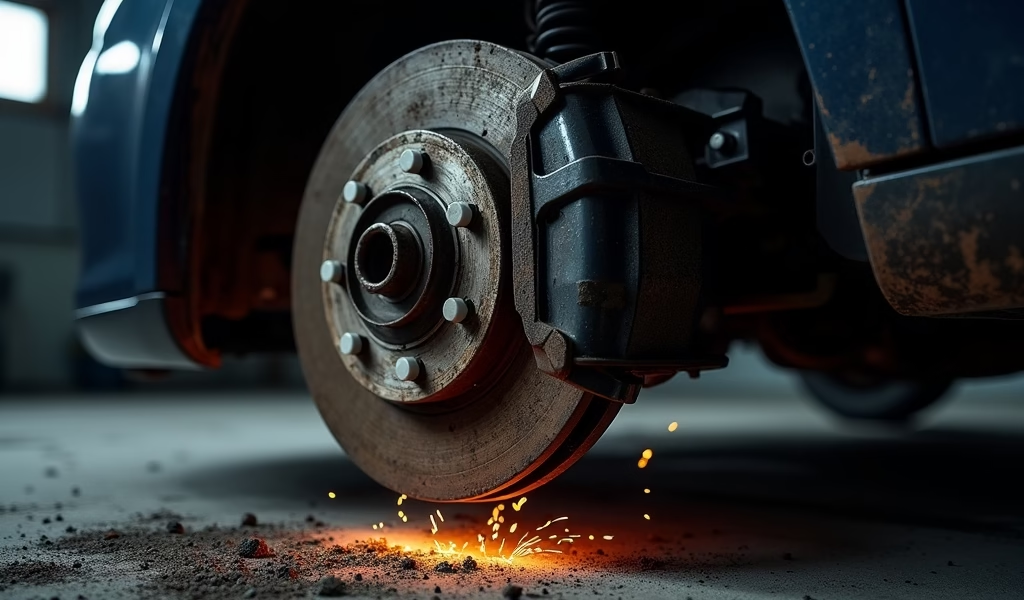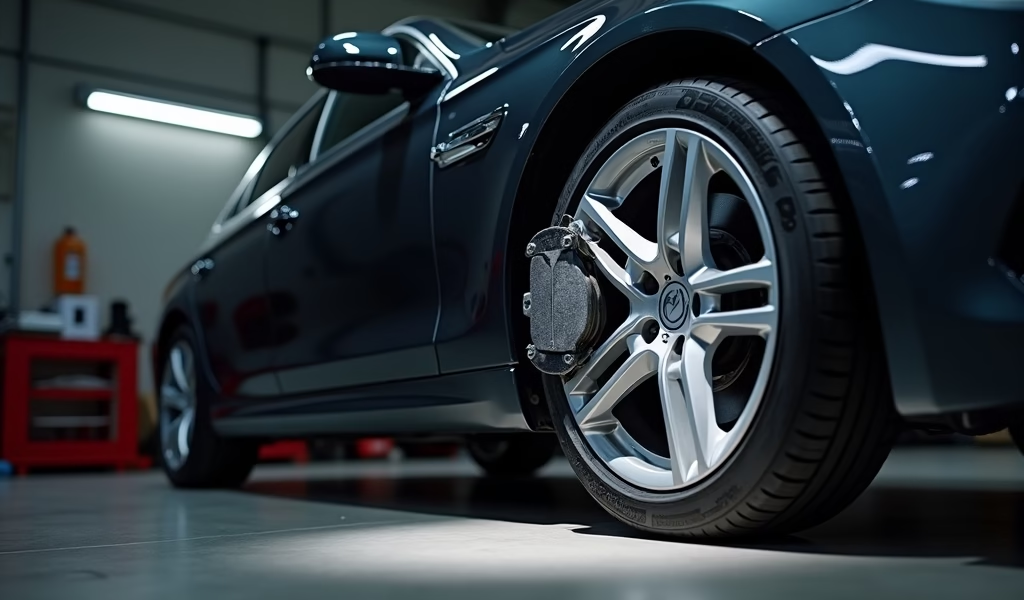Overview
Brake pad replacement typically costs between $150-$300 per axle for professional service, with prices varying based on vehicle type, pad material (organic, semi-metallic, ceramic), service location, and geographic area. DIY replacement can save $100-$250 per axle in labor costs, but requires proper tools and mechanical knowledge, while recognizing warning signs like squealing noises and vibrating brake pedals can help drivers address issues before they require more expensive repairs.
Table of Contents
- Understanding Brake Pad Replacement Costs
- Factors That Affect Brake Pad Replacement Costs
- Complete Price Breakdown: What You’re Actually Paying For
- DIY vs. Professional Brake Pad Replacement
- Smart Ways to Save Money on Brake Pad Replacement
- Warning Signs You Need New Brake Pads
- Conclusion
- Frequently Asked Questions
Ever slammed on your brakes and heard that high-pitched squeal? That’s your car’s way of saying, “Hey buddy, my brake pads are wearing thin!” As a mechanic with 15 years under my belt, I’ve seen countless drivers put off brake pad replacement because they’re worried about costs. The truth is, understanding how much to replace brake pads can save you both money and safety concerns down the road.
Brake pads are the unsung heroes of your vehicle’s safety system. They convert kinetic energy into heat through friction, bringing your 4,000-pound metal machine to a stop. But like your favorite pair of shoes, they wear down over time and eventually need replacing.
In this comprehensive guide, I’ll walk you through everything you need to know about brake pad replacement costs, from the factors that influence pricing to ways you can save money without compromising safety. Let’s dive in!
Understanding Brake Pad Replacement Costs
Before we get into the nitty-gritty, let’s address the question on everyone’s mind: how much does it actually cost to replace brake pads? On average, you can expect to pay between $150 and $300 per axle for a professional brake pad replacement. This typically includes both parts and labor.
However, this range can vary significantly based on several factors we’ll explore shortly. DIY enthusiasts can save considerably by purchasing brake pads for $30-$150 per axle and installing them themselves.
Remember that these figures are for brake pad replacement only. If your rotors need resurfacing or replacement, or if your calipers need work, costs will increase accordingly. It’s like going to the dentist for a cleaning and finding out you need a filling – additional work means additional expenses.
The good news? Regular maintenance and prompt attention to warning signs can help you avoid those surprise costs. Think of it as preventative medicine for your vehicle.
Factors That Affect Brake Pad Replacement Costs

Several key factors influence how much you’ll pay for brake pad replacement:
Vehicle Make and Model
Your car’s DNA plays a huge role in replacement costs. Parts for a Toyota Corolla will generally be less expensive than those for a Mercedes-Benz. Luxury and performance vehicles often require specialty brake pads designed to handle higher heat and stress, which come with premium price tags.
Additionally, some vehicles have more complex braking systems that take longer to service, increasing labor costs. European imports typically cost 20-30% more for brake work compared to domestic or Japanese vehicles, according to industry research on brake market trends.
Brake Pad Material
Brake pads come in several materials, each with its own price point and performance characteristics:
- Organic: $30-$50 per axle. These are the most affordable option, made from materials like rubber, glass, and fiber. They’re quieter but wear faster and produce more dust.
- Semi-metallic: $50-$80 per axle. These contain 30-65% metal (usually copper or steel) mixed with fillers and friction modifiers. They offer a good balance of performance, longevity, and cost.
- Ceramic: $70-$150+ per axle. The premium choice, ceramic pads are quieter, cleaner (less brake dust), and last longer than other options. They’re ideal for daily drivers who want performance without the noise.
- Performance/Racing: $100-$250+ per axle. Designed for high-performance vehicles, these specialized pads offer superior stopping power but at a significant cost premium.
Service Location
Where you get your brake pads replaced significantly impacts the final bill:
- Dealership: $250-$500+ per axle. Dealerships typically charge the highest rates but offer manufacturer-trained technicians and OEM parts.
- Independent repair shops: $150-$300 per axle. These shops often provide quality service at more reasonable rates than dealerships.
- Chain auto shops: $150-$250 per axle. Places like Midas or Firestone frequently run specials on brake service.
- DIY: $30-$150 for parts only. The most economical option if you have the tools and know-how.
Geographic Location
Just like the housing market, brake pad replacement costs vary by region. Labor rates in urban areas like New York City or San Francisco can be 30-50% higher than in rural locations. This geographical price variance reflects the local cost of living, overhead expenses, and market competition.
Complete Price Breakdown: What You’re Actually Paying For
Let’s break down what goes into that final bill when you replace your brake pads:
Parts Cost
- Brake pads: $30-$150 per axle
- Hardware kit (clips, shims, pins): $5-$20
- Brake lubricant: $5-$10
Labor Cost
- Average labor time: 1-2 hours per axle
- Shop rates: $80-$150 per hour
Additional Potential Costs
- Rotor resurfacing: $15-$40 per rotor
- Rotor replacement: $50-$200+ per rotor
- Caliper rebuilding/replacement: $100-$350+ per caliper
- Brake fluid flush: $60-$120
Many drivers are surprised to learn that the pads themselves are often the least expensive part of the job. It’s the labor and potential additional repairs that can really add up. This is why getting a thorough inspection and detailed estimate before authorizing work is so important.
When a shop quotes you for brake pad replacement, always ask what’s included. Some shops advertise low prices for basic pad replacement but then add on “necessary” services. A transparent shop will explain what work is truly needed versus what’s optional.
DIY vs. Professional Brake Pad Replacement
Considering replacing your brake pads yourself? Let’s weigh the pros and cons:
DIY Advantages
- Cost savings: Save $100-$250+ per axle on labor costs
- Quality control: Choose exactly which parts to use
- Satisfaction: The pride that comes with maintaining your own vehicle
- Learning: Gain valuable mechanical knowledge and skills
DIY Disadvantages
- Tool investment: You’ll need jack stands, wrenches, C-clamps, and possibly specialized tools
- Time commitment: Expect 2-4 hours for your first attempt
- No warranty: If something goes wrong, you’re responsible
- Safety concerns: Improperly installed brake pads can be dangerous
Who Should DIY?
DIY brake pad replacement is best suited for those who:
- Have basic mechanical aptitude and patience
- Own or are willing to invest in proper tools
- Have access to a safe workspace
- Are comfortable following detailed instructions or video tutorials
- Understand the safety implications of brake work
If you’re considering the DIY route, numerous quality video tutorials are available online. The Brake Squad’s detailed guide offers excellent step-by-step instructions for beginners.
When to Choose a Professional
Despite the cost savings, some situations warrant professional installation:
- Your vehicle has electronic parking brakes or complex systems
- You notice unusual brake behavior (pulling, pulsating, etc.)
- You lack proper tools or workspace
- You’re uncomfortable with the responsibility of safety-critical work
Remember, brakes are literally what stand between you and an accident. If you have any doubts about your ability to complete the job correctly, the cost to replace brake pads professionally is worth the peace of mind.
Smart Ways to Save Money on Brake Pad Replacement

Whether you choose DIY or professional installation, here are some savvy ways to minimize brake pad replacement costs:
For DIY Repairs
- Shop around for parts: Check multiple auto parts stores and online retailers for the best prices
- Buy complete kits: Look for brake kits that include pads, hardware, and lubricant
- Consider mid-range pads: Unless you drive a performance vehicle, mid-grade pads often provide the best value
- Borrow specialty tools: Many auto parts stores loan tools for free with a refundable deposit
For Professional Service
- Get multiple quotes: Call at least three reputable shops for estimates
- Ask about price matching: Some shops will match competitors’ written quotes
- Look for coupons and specials: Many shops offer seasonal brake specials
- Bundle services: If your car needs other maintenance, ask if there’s a discount for doing it all at once
- Supply your own parts: Some independent shops will install parts you provide (though they may not warranty the labor)
Long-term Money-Saving Tips
- Choose quality over price: Better pads may cost more upfront but save money over time by lasting longer
- Consider lifetime warranty pads: Some premium pads offer lifetime warranties on the parts
- Practice gentle driving: Aggressive braking wears pads faster
- Address issues promptly: Catching brake problems early prevents more expensive damage
- Follow maintenance schedules: Regular brake inspections can identify wear before it becomes problematic
Remember, the cheapest option isn’t always the most economical in the long run. Quality parts installed correctly will generally save you money over time, even if they cost more initially.
Warning Signs You Need New Brake Pads
Knowing when your brake pads need replacement helps you budget appropriately and avoid more costly repairs. Here are the telltale signs to watch for:
Audible Warning Signs
- Squealing or squeaking: Most brake pads include wear indicators that create a high-pitched noise when pads are getting thin
- Grinding or growling: This metal-on-metal sound means you’ve worn through the pad material completely – immediate attention required!
- Clicking: May indicate loose brake pads or hardware
Physical Warning Signs
- Vibrating brake pedal: Often indicates warped rotors from overheating
- Soft or spongy pedal feel: Could signify air in the brake lines or fluid issues
- Vehicle pulling to one side: May indicate uneven brake pad wear or a stuck caliper
Visual Warning Signs
- Thin brake pads: Visually inspect your brake pads – they should be at least 1/4 inch thick
- Warning light: Many newer vehicles have brake pad wear sensors that trigger dashboard warnings
- Excessive brake dust: A sudden decrease in brake dust on your wheels can indicate worn-out pads
If you notice any of these warning signs, it’s time to check your brake pads. Continuing to drive with worn pads can damage your rotors, leading to a much more expensive repair bill. It’s like ignoring a small leak in your roof – what starts as a minor issue can quickly become a major problem.
Most manufacturers recommend replacing brake pads when they reach about 3-4mm thickness. For reference, new pads are typically 10-12mm thick. Many repair shops will check your brake pad thickness during routine maintenance like oil changes – just ask!
Conclusion
Replacing your brake pads is an inevitable part of vehicle ownership, but it doesn’t have to break the bank. By understanding what influences costs, recognizing when replacement is necessary, and exploring your options between DIY and professional service, you can make informed decisions that prioritize both safety and savings.
Remember that when it comes to brakes, cutting corners can be dangerous. Invest in quality parts appropriate for your vehicle and driving style, and don’t ignore warning signs – the cost of prevention is always lower than the cost of repair after failure.
Whether you’re a weekend warrior ready to tackle brake pad replacement in your garage or someone who prefers leaving it to the professionals, I hope this guide has given you the knowledge to approach the process with confidence. After all, understanding how much to replace brake pads is about more than just the price tag – it’s about investing in your vehicle’s longevity and your personal safety.
Drive safely out there, and remember: your brakes are only as good as the pads that power them!
Frequently Asked Questions
How often should brake pads be replaced?
Most brake pads need replacement every 30,000 to 70,000 miles, depending on driving habits and pad material. City drivers typically need more frequent replacements than highway drivers due to the increased braking frequency.
Can I replace just one set of brake pads?
While technically possible, it’s best to replace brake pads in axle pairs (both front or both rear) for balanced braking performance. Uneven braking can cause pulling and unsafe driving conditions.
How long does a brake pad replacement take?
A professional mechanic typically completes a brake pad replacement in 1-2 hours per axle. DIYers should allow 2-4 hours for their first attempt, especially if they’re learning the process.
Is it dangerous to drive with worn brake pads?
Yes, driving with worn brake pads is dangerous as it significantly increases stopping distance and can damage rotors. Once you hear grinding, you’re risking brake failure and costly rotor damage.
Can I replace brake pads without replacing rotors?
Yes, you can often replace just the brake pads if the rotors are still within specifications for thickness and have no significant grooves or hot spots. Most rotors can last through two or more pad changes before requiring replacement.

